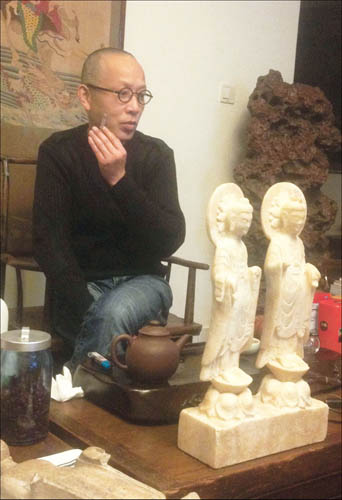 |
|
Zhang Xiongxiong, a 53-year-old collector, shares a quiet moment with his Buddha statues. Nearly two decades ago, Zhang focused on the Buddha statues at local antique shops.
|
While statues of the Buddha and similar objects were once not as prized as other antiques, that has changed. Wang Jie enlightens us.
China’s world of luxury
For many people, luxury is about obviously expensive, imported brands of fashion, handbags, shoes, jewelry, watches, automobiles, houses, vacation destinations, costly cuisine and so on.
One dictionary describes “luxury” as: 1) the state of great comfort and extravagant living; 2) an inessential, desirable item that is expensive or difficult to obtain.
Real Chinese luxury can be much more subtle, simple and understated.
In this biweekly series on luxury in China, we explore its varieties and meanings past and present.
Around 1,900 years ago, Buddhism arrived in China, though it did not become widespread until the 4th century AD. At that time, Buddhist art began to flourish and became a permanent part of China’s artistic heritage.
Buddhist architecture and sculpture thrived in the Sui (AD 581-618) and Tang (AD 618-907) dynasties; the latter was particularly open to foreign influence.
With Buddhism, the representation of the Buddha and the bodhisattvas and attendant figures became the great theme of sculpture. The forms of these figures came to China from India by way of Central Asia. But in the 6th century AD, Chinese artists succeeded in developing a national style in these sculptures.
The style reached its greatest distinction in the Tang Dynasty. Figures beautiful in proportion and graceful in gesture show a precision and clarity in the rendering of form, with a predominance of linear rhythms.
However, collections of ancient Buddha statues, whether in stone, porcelain or gold, were not as popular as other Chinese antiques for several decades.
The spark that ignited the fever in ancient Chinese Buddha statues appeared at a Sotheby’s special auction for the statuary in Hong Kong in 2006. One Buddha statue from the Ming Dynasty (1368-1644) was sold for 104 million yuan (US$17.2 million). Since then, the price of ancient Chinese Buddha statues has rocketed from tens of thousands of yuan to several million yuan.
But Zhang Xiongxiong, a 53-year-old collector, was a step ahead of others. Nearly two decades ago, he focused on the Buddha statues at local antique shops.
“At that time, my friends and relatives all thought that I was crazy,” he says, “because they didn’t think of any reason to buy them. But I was so fascinated.
“The stunning curves and the expressions of the Buddha manifested such a high standard of artistic taste and sculpting technique among our ancestors,” he adds.
We Recommend:
